The WindDancer Foundation Inc. would like to graciously thank Michael Francis for all the wild horse & burro images that appear on our web site. I shared an evening with him and the family over dinner in his Montana home before making the choice of slides I wanted to have permission to use. Those images are in print in his shared coffee table book, “Into the Wind,” with Jay F. Kirkpatrick.
Michael H. Francis
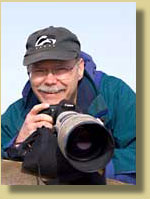
photo courtesy of
Bob Reynolds
Michael H. Francis is a full-time internationally published wildlife and scenic photographer whose 500,000 plus images express his admiration for all of nature. Mike brings his background as a biologist and entomologist to his photos which show extraordinary mammal, bird, reptile and insect behavior as well as striking and beautiful images. Mike is a member and former president of the North American Nature Photography Association and a member of The Outdoor Writers Association of America. He has been published in over 35 single photographer books including Elk Country, Mule Deer Country, Yellowstone Bears in the Wild, Into the Wind … Wild Horses of North America, Bison for Kids, Yellowstone Memories, and many more. Mike's credits also include thousands of images published in a broad variety of magazines and books including Sports Afield, Audubon, Field and Stream, Outdoor Life, Ranger Rick, Natural History, Outdoor Photographer, and National Geographic Books. His images are also published in hundreds of calendars, postcards, greeting cards, mugs and even on the sides of Frontier Airlines planes.
In addition to taking photos throughout the world, Mike leads photo tours to Alaska, Africa, Yellowstone, Texas, North and South Dakota and other locations. He enjoys sharing his love of wildlife with experienced and beginner wildlife photographers of any age. His insights into animal behavior and broad experience make for a rich photography tour experience.
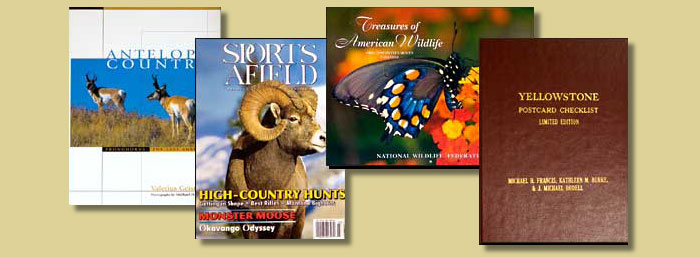
Mike began his love of photography in Yellowstone National Park where he worked for fifteen seasons managing hotels and lodges for the concessionaire. He actively hiked and climbed mountains throughout Yellowstone and in doing so began his career in taking photos over 30 years ago. In addition to taking photos of the wildlife and scenery Mike has an extensive Yellowstone ephemera collection and with two other Yellowstone enthusiasts he has published the Yellowstone Postcard Checklist, a must for Yellowstone postcard collectors.
Mike is a strong supporter of new photographers entering the field. He has sponsored both high school and college students in the North American Nature Photography Association Scholarship programs. He regularly gives speeches and slide shows for photography clubs and schools. Mike is happy to share his experience with those who love wildlife and cameras.
Mike lives in Billings, Montana, with his wife Tori and daughters Elizabeth and Emily. He shares his backyard with a variety of birds and his 25 turtles and tortoises.
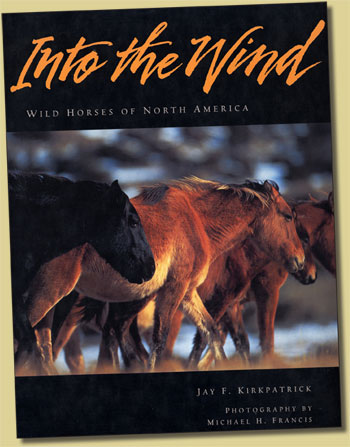
The wild horse, running free into the sunset or standing proud and defiant on a craggy mountain cliff, has long symbolized the true spirit of freedom in our country. Stories of these gallant wild creatures are full of romance, myth, and mystery. Into the Wind is both a celebration of these beautiful, wild animals and a definitive work on their true origin and natural history. The struggle of wild horses to survive and thrive in our ever advancing civilization has not been an easy one.
They have been abandoned and adopted, hunted and haunted, and finally, only in recent years, appreciated and revered for their exquisite intrinsic value.
The wild horse’s tremendous capacity for survival, its unique social behaviors, and its heart-stopping power and nobility, all collide with beauty and drama in this memorable book of the profound personal experience of Jay F. Kirkpatrick and the awesome photography by Michael H. Francis.....
See some of Michael's work at www.michaelfrancisphoto.com.

Hope Ryden

Author-Naturalist Hope Ryden has spent years in the field, studying and photographing North American wildlife. Her behavioral findings have been published in National Geographic, Smithsonian, and Audubon magazine, and her books have been translated into German, Swedish, Finnish, Norwegian, Dutch, Spanish, Italian and Russian. To date she has twenty-three books to her credit, all of which are illustrated with her own photography. Her most recent titles can be ordered through Barnes and Noble.com or Amazon.com. Some of her earlier books can be ordered directly from her or from iUniverse.com. Hope is available for school programs, and she also lectures for adult audiences. Her wildlife photographs are handled by the National Geographic’s Image Collection or can be ordered directly from her at hoperyden.com.
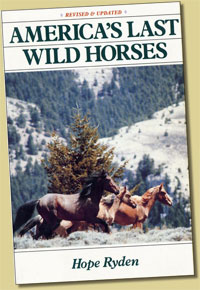
Special recognition
• Art and Literary Award 2002 from New York State
• Outdoor Education Association
• Outstanding Achievement Award from Augustana College
• Hall of Honor Moline High School
• Humane Excellence Award ASPCA
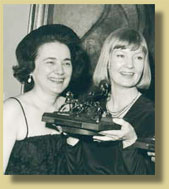
• Joseph Wood Krutch Award from the Humane Society of the United States
• Animal Humanitarian of the Year Award from the Animal Protection Institute of America
• Humanitarian of the Year Award from the American Horse Protection Society
• Who’s Who of American Women
• Who’s Who in the East

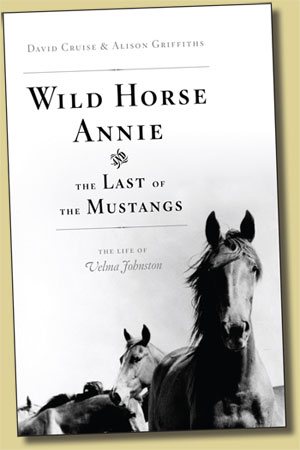
Wild Horse Annie
The Story of Velma Johnson
In one of the year’s most stirring biographies, David Cruise and Alison Griffiths paint a vivid portrait of Velma Johnston, an intrepid Nevada secretary whose dedication to wild mustangs captured the heart of the country and led to legislation that would preserve the animals who embody the wild spirit of the American West. WILD HORSE ANNIE AND THE LAST OF THE MUSTANGS: THE LIFE OF VELMA JOHNSTON is the first to tell Velma’s remarkable story.
Combining innovative tactics with unflinching determination, Velma embarked on dangerous missions to free captured horses and document the cruel practices of mustang herders and slaughterhouses, enlisted the powerful support of key journalists and politicians, and started a letter-writing campaign that flooded Congress with mail. Ultimately, she was responsible for spurring Congress into passing legislation that protected wild horses. Her fight, which earned her the initially derisive nickname “Wild Horse Annie,” captivated the attention and gained the support of tens and thousands of horse lovers around the world.

WILD HORSE ANNIE follows Velma from her youth through the three-decade campaign in which she took on herders, ranchers, legislators, and the Bureau of Land Management in a David vs. Goliath fight. As a child, Velma was stricken with polio, which fostered a resolve that she channeled into her lifelong battle as an advocate for the mustangs. In 1950, her life changed when, on her way to work, she encountered a truck of battered mustangs that had been rounded up to be slaughtered for pet food. Velma vowed to stop the cruel treatment of mustangs and launched a highly organized one-woman campaign to raise public awareness of their plight. To Velma, mustangs represented the freedom and beauty that she, with a body crippled and disfigured by polio, did not have.
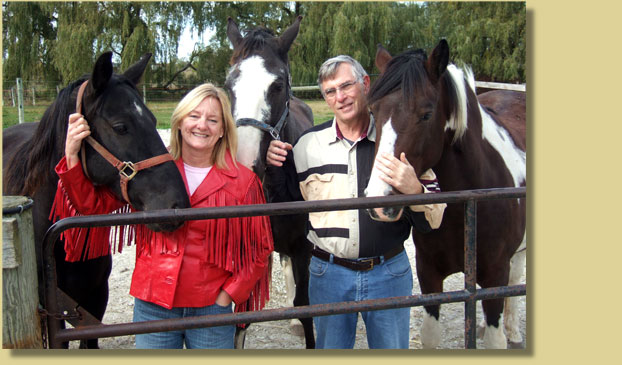
Alison Griffiths and David Cruise, authors

Unbroken Spirit
A special thanks to the Buffalo Bill Museum for sharing the information from Unbroken Spirit Online to educate the readers of the WindDancer Foundation Inc. website. The information contained on our Education section is vital to understanding the historical view of the mustangs and burros that reside on our public lands.
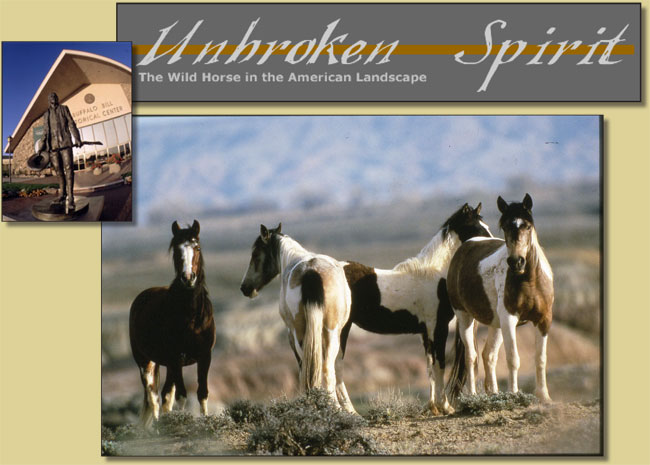
They are the winddrinkers of the Great Plains, carrying 57 million years of evolutionary history in their blood. Wild horses are beloved and hated, revered and condemned. They represent wildness and domestication -- all at the same time. Nevertheless, they are protected under federal law and allowed to roam freely on the federal rangelands of the western United States.
In Unbroken Spirit Online, you will learn more about their long, complex evolution in North America, extinction during the late-Pleistocene Epoch, genetic makeup and biology, primitive behaviors and social organization, domestication and place in human history, near extermination through mustanging, protective legislation, and the controversy that surrounds them today. The “wild horse” will take on new dimension and meaning, with enhanced understanding of its place in the natural world and in the history and advancement of civilization.